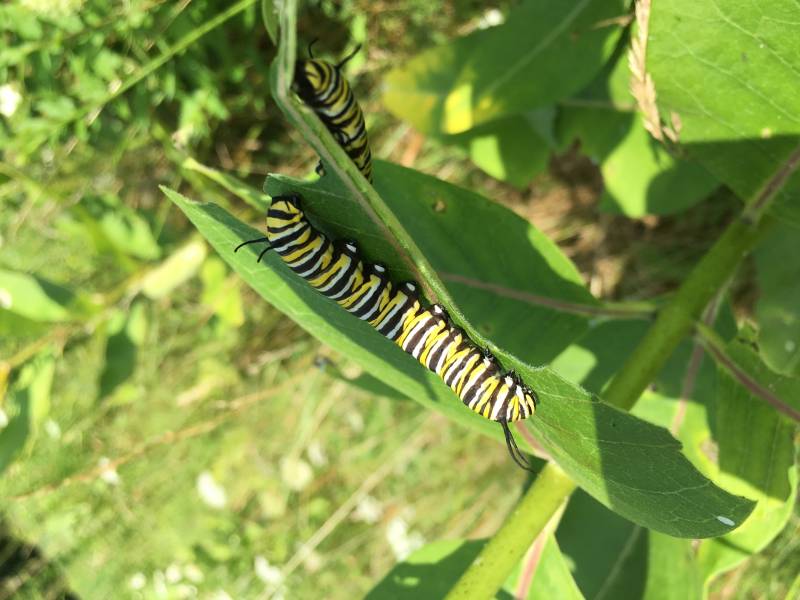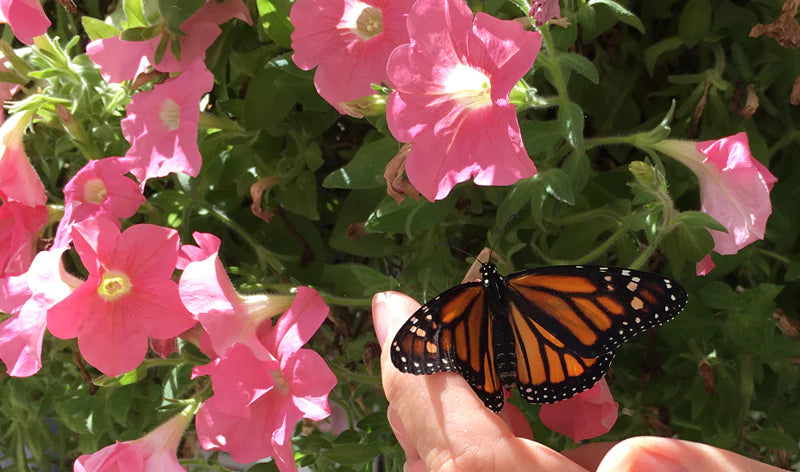1. Plant Milkweed
 Planting milkweed is by far the most purposeful thing you can do in saving the monarch butterfly from extinction. Milkweed is the sole source of habitat and food for monarch caterpillars. Furthermore, milkweed flowers provide essential nectar and nutrition to monarch butterflies. Milkweed is where monarch conservation begins and ends in the USA.
Planting milkweed is by far the most purposeful thing you can do in saving the monarch butterfly from extinction. Milkweed is the sole source of habitat and food for monarch caterpillars. Furthermore, milkweed flowers provide essential nectar and nutrition to monarch butterflies. Milkweed is where monarch conservation begins and ends in the USA.2. Plant Milkweed

Sorry. But in the last few decades we've lost most of our continent's milkweed due to the pervasive use of the herbicide Round Up on crops. Researchers report that 80-90+ percent of all corn and soybean crops in the United States are grown with "Round-up Ready" seeds. They have been genetically modified to be resistant to RoundUp. The herbicide is sprayed heavily on crops to kill weeds. GMO crops survive but milkweed is wiped out. That's why we've had a catastrophic loss of milkweed and the monarchs that need it for habitat and food.
3. Know Your Milkweed
 It's important to know which milkweed varieties (there are nearly 100) are native to your area. Find out using this US Forest Service map. Planting the wrong kind of milkweed has been shown to disrupt migration and increase levels of OE disease (ref: Science).
It's important to know which milkweed varieties (there are nearly 100) are native to your area. Find out using this US Forest Service map. Planting the wrong kind of milkweed has been shown to disrupt migration and increase levels of OE disease (ref: Science).4. Start Lots of Milkweed Seedlings
 We planted about 200 milkweed seedlings using this vernalization method (scroll to Stratification). In March, we planted 2-3 milkweed seeds in each of these moistened pods and placed the whole trays in the fridge for 3-6 weeks. Nearly every seed germinated!
We planted about 200 milkweed seedlings using this vernalization method (scroll to Stratification). In March, we planted 2-3 milkweed seeds in each of these moistened pods and placed the whole trays in the fridge for 3-6 weeks. Nearly every seed germinated!A couple of milkweed plants is not enough to help the monarchs, at least not during the first few years before your milkweed starts to spread. Female monarchs lay hundreds of eggs each. They prefer to lay just one egg per milkweed plant. So be generous! Plant lots of seedlings.
5. Plant Milkweed Adjacent to Sturdy Plants
 It's ideal if your milkweed is located near a bush like this oak leaf hydrangea in our garden. If you look carefully to the left of this monarch, you'll see the empty chrysalis casing it just emerged from. The leaf made a perfect umbrella.
It's ideal if your milkweed is located near a bush like this oak leaf hydrangea in our garden. If you look carefully to the left of this monarch, you'll see the empty chrysalis casing it just emerged from. The leaf made a perfect umbrella.After a mother monarch lays her eggs on your milkweed plants, caterpillars will emerge. They'll gobble up milkweed leaves for about 2 weeks, then they'll be ready to form a chrysalis. Caterpillars look for a sturdy place to transform; one that will provide shelter from wind and rain and predators. Sturdy bushes, nearby porches and garden furniture can all make great shelters for chrysalises.
6. Have a Backup Supply of Milkweed
 On the left is a patch of milkweed before 1 monarch began laying eggs on it. On the right is that same milkweed patch about a week later. A single monarch can lay hundreds of eggs. Hungry caterpillars chow through milkweed at an amazing rate so it's good to know where a back-up supply might be growing.
On the left is a patch of milkweed before 1 monarch began laying eggs on it. On the right is that same milkweed patch about a week later. A single monarch can lay hundreds of eggs. Hungry caterpillars chow through milkweed at an amazing rate so it's good to know where a back-up supply might be growing.7. Locate Your Milkweed In or Near Your Flower Garden
 After a monarch butterfly emerges from its chrysalis, it needs to eat flower nectar. Saving the monarch butterfly means providing summer and fall flowers to supply nectar that fuels the butterflies on their long journey to Mexico.
After a monarch butterfly emerges from its chrysalis, it needs to eat flower nectar. Saving the monarch butterfly means providing summer and fall flowers to supply nectar that fuels the butterflies on their long journey to Mexico.8. Give Milkweed 3 Years to Spread
 Here's a field where milkweed was allowed to spread and thrive. You can tell these are mature plants because it takes 3 years for milkweed to start producing seeds pods.
Here's a field where milkweed was allowed to spread and thrive. You can tell these are mature plants because it takes 3 years for milkweed to start producing seeds pods.9. Don't Buy Caterpillars
 As recently as a few years ago, some scientists in the monarch community were selling farmed monarch caterpillars. The idea was to help increase the monarch population by enlisting citizen scientists to rear the caterpillars until they transformed into butterflies. Research has shown that was a bad idea (ref: NPR story). We now know that farmed caterpillars often do not migrate. Scientists worry that when they breed with wild monarchs they weaken the species. So, no farmed caterpillars!
As recently as a few years ago, some scientists in the monarch community were selling farmed monarch caterpillars. The idea was to help increase the monarch population by enlisting citizen scientists to rear the caterpillars until they transformed into butterflies. Research has shown that was a bad idea (ref: NPR story). We now know that farmed caterpillars often do not migrate. Scientists worry that when they breed with wild monarchs they weaken the species. So, no farmed caterpillars!10. Help Monarchs Avoid Predators
 Here's a brand new butterfly that just emerged from its chrysalis. As a caterpillar and chrysalis it was easy prey for spiders, hornets and other garden predators. I cleared spider webs away from it several times. A long, thin paint brush works well for that.
Here's a brand new butterfly that just emerged from its chrysalis. As a caterpillar and chrysalis it was easy prey for spiders, hornets and other garden predators. I cleared spider webs away from it several times. A long, thin paint brush works well for that.Now Share Your Monarchs!
It's a joy to watch the monarch miracle in action. Share the fun! At Vermont Woods Studios we give away milkweed seeds and seedlings and caterpillars to anyone who stops by and asks for them. That's how the monarch community is. By helping each other and reaching out to neighbors & friends we are making a difference. Monarch numbers are up this year! Please join us on Facebook and get involved. You're going to love it.
For more information on gardening for monarchs, hop on over to The Porch and read A Tribute To The Monarch Butterfly: How to Turn Your Backyard Into a Butterfly Friendly Habitat


